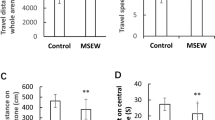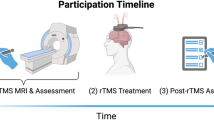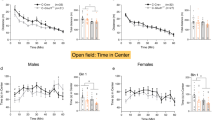Abstract
Growing evidence implicates a critical involvement of prefrontal glial modulation of extracellular glutamate (GLU) in aversive behaviors. However, nothing is known about whether prefrontal glial cells modulate GLU levels in rewarding behaviors. To address this question, we measured GLU efflux in the medial prefrontal cortex (PFC) of rats associated with rewarding behaviors. We used intracranial self-stimulation (ICSS) of the medial forebrain bundle (MFB) as the rewarding behavior. GLU was indirectly measured using microdialysis combined with on-line fluorometric detection of NADH resulting from the reaction of GLU and NAD+ catalyzed by GLU dehydrogenase with a time resolution of 1 min. ICSS caused a minute-by-minute change of extracellular GLU in the medial PFC, with a slight decrease during the stimulation, followed by an increase afterward. This bidirectional change was tetrodotoxin insensitive and abolished by the gliotoxin fluorocitrate. To confirm and extend the previous studies of aversion-induced increase of extracellular GLU in the medial PFC, we also measured prefrontal GLU efflux associated with an aversive stimulation, immobilization stress. The temporal change in extracellular GLU caused by this stress was markedly different from that observed during ICSS. A rapid increase in GLU was detected during the aversive stimulation, followed by a large increase afterward. This bimodal change was tetrodotoxin insensitive, similar to that detected for ICSS. These findings indicate a bidirectional regulation of extracellular GLU by prefrontal glial cells associated with rat ICSS behavior, and reveal that glial modulation of GLU neurochemistry in the medial PFC contributes to rewarding as well as aversive behaviors in rats.
Similar content being viewed by others
Log in or create a free account to read this content
Gain free access to this article, as well as selected content from this journal and more on nature.com
or
References
Abrams R, Hammel HT (1964). Hypothalamic Temperature in Unanesthetized Albino Rats during Feeding and Sleeping. Am J Physiol 206: 641–646.
Anderson CM, Swanson RA (2000). Astrocyte glutamate transport: review of properties, regulation, and physiological functions. Glia 32: 1–14.
Bagley J, Moghaddam B (1997). Temporal dynamics of glutamate efflux in the prefrontal cortex and in the hippocampus following repeated stress: effects of pretreatment with saline or diazepam. Neuroscience 77: 65–73.
Baker DA, Xi ZX, Shen H, Swanson CJ, Kalivas PW (2002). The origin and neuronal function of in vivo nonsynaptic glutamate. J Neurosci 22: 9134–9141.
Banasr M, Chowdhury GM, Terwilliger R, Newton SS, Duman RS, Behar KL et al (2010). Glial pathology in an animal model of depression: reversal of stress-induced cellular, metabolic and behavioral deficits by the glutamate-modulating drug riluzole. Mol Psychiatry 15: 501–511.
Banasr M, Duman RS (2008). Glial loss in the prefrontal cortex is sufficient to induce depressive-like behaviors. Biol Psychiatry 64: 863–870.
Bechtholt-Gompf AJ, Walther HV, Adams MA, Carlezon WA Jr, Ongur D, Cohen BM (2010). Blockade of astrocytic glutamate uptake in rats induces signs of anhedonia and impaired spatial memory. Neuropsychopharmacology 35: 2049–2059.
Bekar LK, He W, Nedergaard M (2008). Locus coeruleus alpha-adrenergic-mediated activation of cortical astrocytes in vivo. Cereb Cortex 18: 2789–2795.
Choudary PV, Molnar M, Evans SJ, Tomita H, Li JZ, Vawter MP et al (2005). Altered cortical glutamatergic and GABAergic signal transmission with glial involvement in depression. Proc Natl Acad Sci USA 102: 15653–15658.
Cotter D, Mackay D, Chana G, Beasley C, Landau S, Everall IP (2002). Reduced neuronal size and glial cell density in area 9 of the dorsolateral prefrontal cortex in subjects with major depressive disorder. Cereb Cortex 12: 386–394.
Danbolt NC (2001). Glutamate uptake. Prog Neurobiol 65: 1–105.
D'Suza MS, Markou A (2010) Neural substrates of psychostimulant withdrawal-induced anhedonia In: Self DW, Staley JK (eds) Behavioral Neuroscience of Drug Addiction: Current Topics in Behavioral Neuroscience 3. Springer-Verlag: Berlin Heiderberg: Berlin Heiderbergpp 119–178.
Eshel N, Roiser JP (2010). Reward and punishment processing in depression. Biol Psychiatry 68: 118–124.
Fillenz M (1995). Physiological release of excitatory amino acids. Behav Brain Res 71: 51–67.
Hashimoto K, Sawa A, Iyo M (2007). Increased levels of glutamate in brains from patients with mood disorders. Biol Psychiatry 62: 1310–1316.
Hascup KN, Hascup ER, Pomerleau F, Huettl P, Gerhardt GA (2008). Second-by-second measures of L-glutamate in the prefrontal cortex and striatum of freely moving mice. J Pharmacol Exp Ther 324: 725–731.
Haydon PG, Carmignoto G (2006). Astrocyte control of synaptic transmission and neurovascular coupling. Physiol Rev 86: 1009–1031.
Holtzheimer PE, Mayberg HS (2011). Deep brain stimulation for psychiatric disorders. Annu Rev Neurosci 34: 289–307.
Jackson ME, Moghaddam B (2001). Amygdala regulation of nucleus accumbens dopamine output is governed by the prefrontal cortex. J Neurosci 21: 676–681.
John CS, Smith KL, Van't Veer A, Gompf HS, Carlezon WA Jr, Cohen BM et al (2012). Blockade of astrocytic glutamate uptake in the prefrontal cortex induces anhedonia. Neuropsychopharmacology 37: 2467–2475.
Kalivas PW (2009). The glutamate homeostasis hypothesis of addiction. Nat Rev Neurosci 10: 561–572.
Kiyatkin EA, Brown PL, Wise RA (2002). Brain temperature fluctuation: a reflection of functional neural activation. Eur J Neurosci 16: 164–168.
Kiyatkin EA, Wise RA (2001). Striatal hyperthermia associated with arousal: intracranial thermorecordings in behaving rats. Brain Res 918: 141–152.
Kulkarni SK, Dhir A (2009). Current investigational drugs for major depression. Expert Opin Investig Drugs 18: 767–788.
Lowy MT, Wittenberg L, Yamamoto BK (1995). Effect of acute stress on hippocampal glutamate levels and spectrin proteolysis in young and aged rats. J Neurochem 65: 268–274.
Lupinsky D, Moquin L, Gratton A (2010). Interhemispheric regulation of the medial prefrontal cortical glutamate stress response in rats. J Neurosci 30: 7624–7633.
Mayberg HS, Lozano AM, Voon V, McNeely HE, Seminowicz D, Hamani C et al (2005). Deep brain stimulation for treatment-resistant depression. Neuron 45: 651–660.
McEwen AM, Burgess DT, Hanstock CC, Seres P, Khalili P, Newman SC et al (2012). Increased glutamate levels in the medial prefrontal cortex in patients with postpartum depression. Neuropsychopharmacology 37: 2428–2435.
Mineur YS, Picciotto MR, Sanacora G (2007). Antidepressant-like effects of ceftriaxone in male C57BL/6J mice. Biol Psychiatry 61: 250–252.
Mogensen J, Divac I (1993). Behavioural changes after ablation of subdivisions of the rat prefrontal cortex. Acta Neurobiol Exp (Wars) 53: 439–449.
Moghaddam B, Jackson M (2004). Effect of stress on prefrontal cortex function. Neurotox Res 6: 73–78.
Nakahara D, Ozaki N, Nagatsu T (1993) In vivo microdialysis of neurotransmitters and their metabolites In: SH P, Naoi M, T N, S P (eds) Methods in Neurotransmitters and Neuropeptide Research. Elsevier: Amsterdam: Amsterdampp 219–248.
Nestler EJ, Carlezon WA Jr (2006). The mesolimbic dopamine reward circuit in depression. Biol Psychiatry 59: 1151–1159.
Obrenovitch TP, Sarna GS, Millan MH, Lok SY, Kawauchi M, Ueda Y et al (1990) Intracerebral dialysis with on-line enzyme fluorometric detection: a novel method to investigate the changes in the extracellular concentration of glutamic acid In: Krieglstein J, Oberpichler H (eds) Pharmacology of Cerebral Ischemia 1990 Wiss-Verlag: Stuttgart, Germanypp 23–31.
Oh DH, Oh D, Son H, Webster MJ, Weickert CS, Kim SH (2014). An association between the reduced levels of SLC1A2 and GAD1 in the dorsolateral prefrontal cortex in major depressive disorder: possible involvement of an attenuated RAF/MEK/ERK signaling pathway. J Neural Transm 121: 783–792.
Paulsen RE, Fonnum F (1989). Role of glial cells for the basal and Ca2+-dependent K+-evoked release of transmitter amino acids investigated by microdialysis. J Neurochem 52: 1823–1829.
Paxinos G, Watson C (1986) The Rat Brain in Stereotaxic Coordinates Academic: New York, NY, USA.
Persson M, Ronnback L (2012). Microglial self-defence mediated through GLT-1 and glutathione. Amino Acids 42: 207–219.
Prosser RA, Edgar DM, Heller HC, Miller JD (1994). A possible glial role in the mammalian circadian clock. Brain Res 643: 296–301.
Rada P, Tucci S, Murzi E, Hernández L (1997). Extracellular glutamate increases in the lateral hypothalamus and decreases in the nucleus accumbens during feeding. Brain Res 768: 338–340.
Rajkowska G (2000). Postmortem studies in mood disorders indicate altered numbers of neurons and glial cells. Biol Psychiatry 48: 766–777.
Reznikov LR, Grillo CA, Piroli GG, Pasumarthi RK, Reagan LP, Fadel J (2007). Acute stress-mediated increases in extracellular glutamate levels in the rat amygdala: differential effects of antidepressant treatment. Eur J Neurosci 25: 3109–3114.
Rutherford EC, Pomerleau F, Huettl P, Strömberg I, Gerhardt GA (2007). Chronic second-by-second measures of L-glutamate in the central nervous system of freely moving rats. J Neurochem 102: 712–722.
Saulskaya NB, Mikhailova MO (2002). Feeding-induced decrease in extracellular glutamate level in the rat nucleus accumbens: dependence on glutamate uptake. Neuroscience 112: 791–801.
Schlaepfer TE, Bewernick BH, Kayser S, Mädler B, Coenen VA (2013). Rapid effects of deep brain stimulation for treatment-resistant major depression. Biol Psychiatry 73: 1204–1212.
Schlaepfer TE, Cohen MX, Frick C, Kosel M, Brodesser D, Axmacher N et al (2008). Deep brain stimulation to reward circuitry alleviates anhedonia in refractory major depression. Neuropsychopharmacology 33: 368–377.
Steciuk M, Kram M, Kramer GL, Petty F (2000). Immobilization-induced glutamate efflux in medial prefrontal cortex: blockade by (+)-Mk-801, a selective NMDA receptor antagonist. Stress 3: 195–199.
Takita M, Kawashima T, kaneko H, Suzuki SS, Yokoi H (2002). Sensitization of glutamate release and N-metthyl-D-aspartate receptor response by transient dopamine pretreatment in prefrontal cortex of rats. Neurosci Lett 317: 97–100.
Tanaka K, Watase K, Manabe T, Yamada K, Watanabe M, Takahashi K et al (1997). Epilepsy and exacerbation of brain injury in mice lacking the glutamate transporter GLT-1. Science 276: 1699–1702.
Timmerman W, Westerink BH (1997). Brain microdialysis of GABA and glutamate: what does it signify? Synapse 27: 242–261.
Vedam-Mai V, van Battum EY, Kamphuis W, Feenstra MG, Denys D, Reynolds BA et al (2012). Deep brain stimulation and the role of astrocytes. Mol Psychiatry 17: 124–131.
You ZB, Chen YQ, Wise RA (2001). Dopamine and glutamate release in the nucleus accumbens and ventral tegmental area of rat following lateral hypothalamic self-stimulation. Neuroscience 107: 629–639.
Zink M, Vollmayr B, Gebicke-Haerter PJ, Henn FA (2010). Reduced expression of glutamate transporters vGluT1, EAAT2 and EAAT4 in learned helpless rats, an animal model of depression. Neuropharmacology 58: 465–473.
Acknowledgements
We thank Dr Kazue Semba for valuable comments on the manuscript, Dr Ryuko Ohashi for assistance during the experiment, and Ms Shino Sugiyama for secretarial assistance.
Author information
Authors and Affiliations
Corresponding author
Additional information
Supplementary Information accompanies the paper on the Neuropsychopharmacology website
Supplementary information
Rights and permissions
About this article
Cite this article
Murakami, G., Nakamura, M., Takita, M. et al. Brain Rewarding Stimulation Reduces Extracellular Glutamate Through Glial Modulation in Medial Prefrontal Cortex of Rats. Neuropsychopharmacol 40, 2686–2695 (2015). https://doi.org/10.1038/npp.2015.115
Received:
Revised:
Accepted:
Published:
Issue date:
DOI: https://doi.org/10.1038/npp.2015.115
This article is cited by
-
Pharmacological mechanisms of interhemispheric signal propagation: a TMS-EEG study
Neuropsychopharmacology (2020)



